Erosion of the FIDESZ vote share in the EP2024 elections - on the brink?
[This is a post about Hungarian politics.]
For the first time in a decade in Hungary, the governing FIDESZ-KDNP party (from here: FIDESZ/the government) saw its vote share fall substantially in the 2024 European Parliament elections (EP2024). There were a range of opinions how bad the results were for FIDESZ, if at all, and what the results portend for the 2026 national elections. Below, I present a number of graphs exploring how much the share and number of votes for FIDESZ changed compared to the last European elections, across different geographies in the country. Finally, I map the results onto parliamentary constituencies and analyse what they could mean in a national election.
- Results at the national level
- Results by individual towns and cities
- Results aggregated by settlement types
- Results by parliamentary constituencies
- Conclusion
Results at the national level
How did the government party perform on the elections on the national level? Figure 1 shows both the share and number of votes cast for FIDESZ, the (non-far-right) opposition bloc and the far-right Mi Hazánk party. I included in the opposition all parties that are explicitly or plausibly in favour of a change of government and that are not to the right of FIDESZ. I also removed business parties and some minor party only running in 2019 (Munkaspart). This then includes within the opposition the following parties EP2019 and EP2024:
- DK/MSZP/Parbeszed (either separate or in coalition)
- Jobbik
- LMP
- MMN (Mindenki Magyarországa Néppárt; only running in 2024)
- Momentum
- TISZA Part (only running in 2024)
The results are summarised in Figure 1 below.
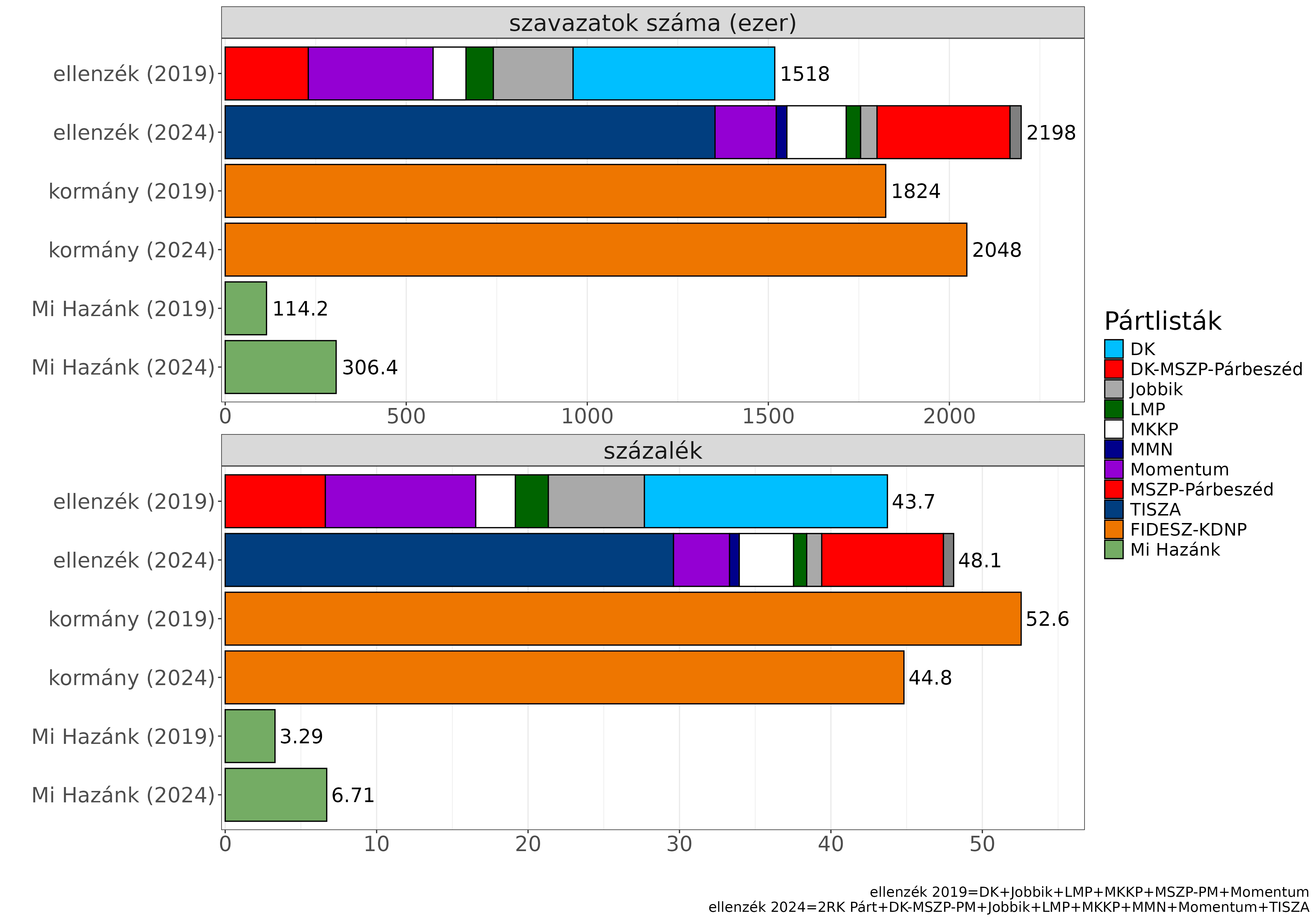
Figure 1: National level results of the 2019 and 2024 EP elections, in absolute numbers (thousands) and percentages. All non-far-right opposition parties were grouped in one column [full resol.]
In 2019 FIDESZ had an absolute majority nationally at 52.6% of the vote, which fell to below 45% (44.8%) in the EP2024. Some commentators argued that these are still good results for the government because in absolute terms they went up, not down.
This is true, in that the FIDESZ voting bloc expanded from 1.82 million to 2.05 million. However, this increase of approximately 200 thousand votes was outdone by the opposition’s 680 thousand vote bump, an almost 3.5x larger increase.
This resulted in the combined opposition vote reaching 48.1% nationally, exceeding FIDESZ by about 150 thousand votes, or 3.3% of (valid) ballots cast. That the non-far-right opposition’s (defining Jobbik as far-right 2008-2018 and Mi Hazánk since its inception) vote share were larger than (or equal to) FIDESZ’s last happened in the 2006 general elections. In fact, in all three EP elections since 2009 FIDESZ had more than half of the national vote, just as it did in all general elections since 2010, except in 2014 (technically 49.3% in 2018).
Another notable development from 2019 to 2024 are the gains by the Mi Hazánk party, doubling their vote share to 6.7%, by 192 thousand votes.
How did this \(\approx\)8% slump in the Fidesz vote share come about geographically?
Results by individual towns and cities
To analyse changes of the electoral map, I grouped all settlements, towns and cities into the following groups, by the number of eligible voters (ie. these numbers are adults only, which is \(\approx\)80% of the total population):
- villages with less than 1000 voters
- villages/small towns with 1000 to 5000 voters
- small towns with 5000 to 10,000 voters
- towns/smaller cities with 10,000 to 20,000 voters
- smaller/medium cities with 20,000 to 40,000 voters
- cities with 40,000 to 70,000 voters
- large cities with more than 70,000 voters
- Budapest districts
Figure 2 shows how the vote share of FIDESZ changed from EP2019 to 2024 across all these geographies. The blue colour shows a fall in the government vote share, whereas red (using red here instead of orange because of its better visibility) shows those settlements/towns/cities where its vote share went up.
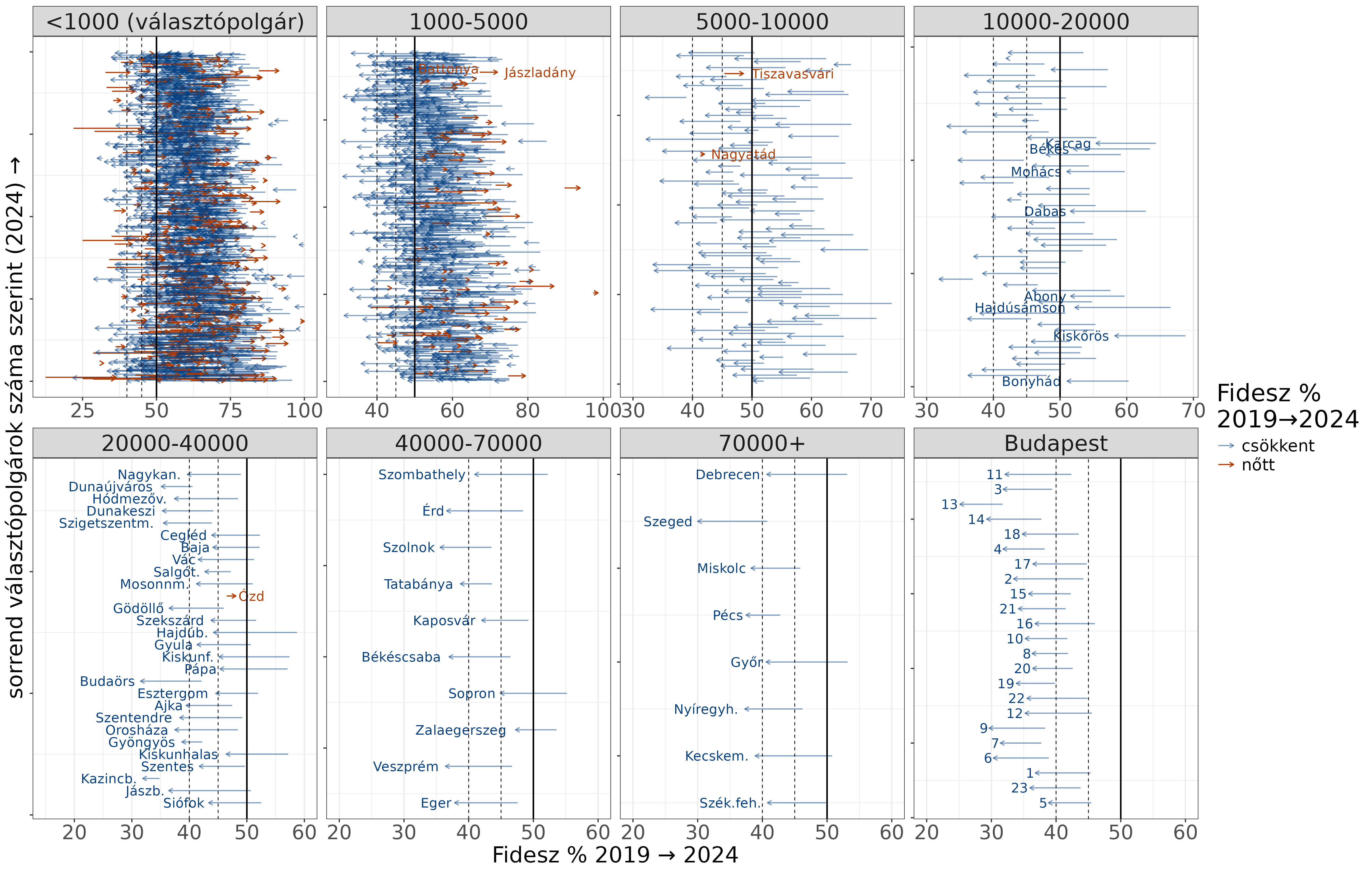
Figure 2: FIDESZ vote share in 2019 and 2024 (arrowhead=2024, base=2019) in all settlements of Hungary. Blue color shows a fall in the vote share [full resol.]
The FIDESZ vote share went down in every town/city with more than 10 thousand voters, with the single exception of Ózd. To see the extent of the change in the vote share, Figure 3 shows only the percentage difference between EP2019 and 2024. Even among towns of 5 to 10 thousand voters there are only two where the government vote share increased (Nagyatád, Tiszavasvári); and not very many small towns of 1 to 5 thousand where it did either (93 out of 943 towns). The government vote share fell typically by 5-10% in larger towns and cities, but in smaller towns of 1 to 10 thousand voters often by even more.

Figure 3: FIDESZ vote share in 2019 and 2024 in all settlements of Hungary (0=2019 result). Blue color shows a fall in the vote share [full resol.]
On Figure 2 it is also apparent that among towns with <20 thousand voters FIDESZ still had an absolute majority. The colour coding in Figure 4 shows the towns/cities where the government vote share was still above 50% in 2024 (shown in red).
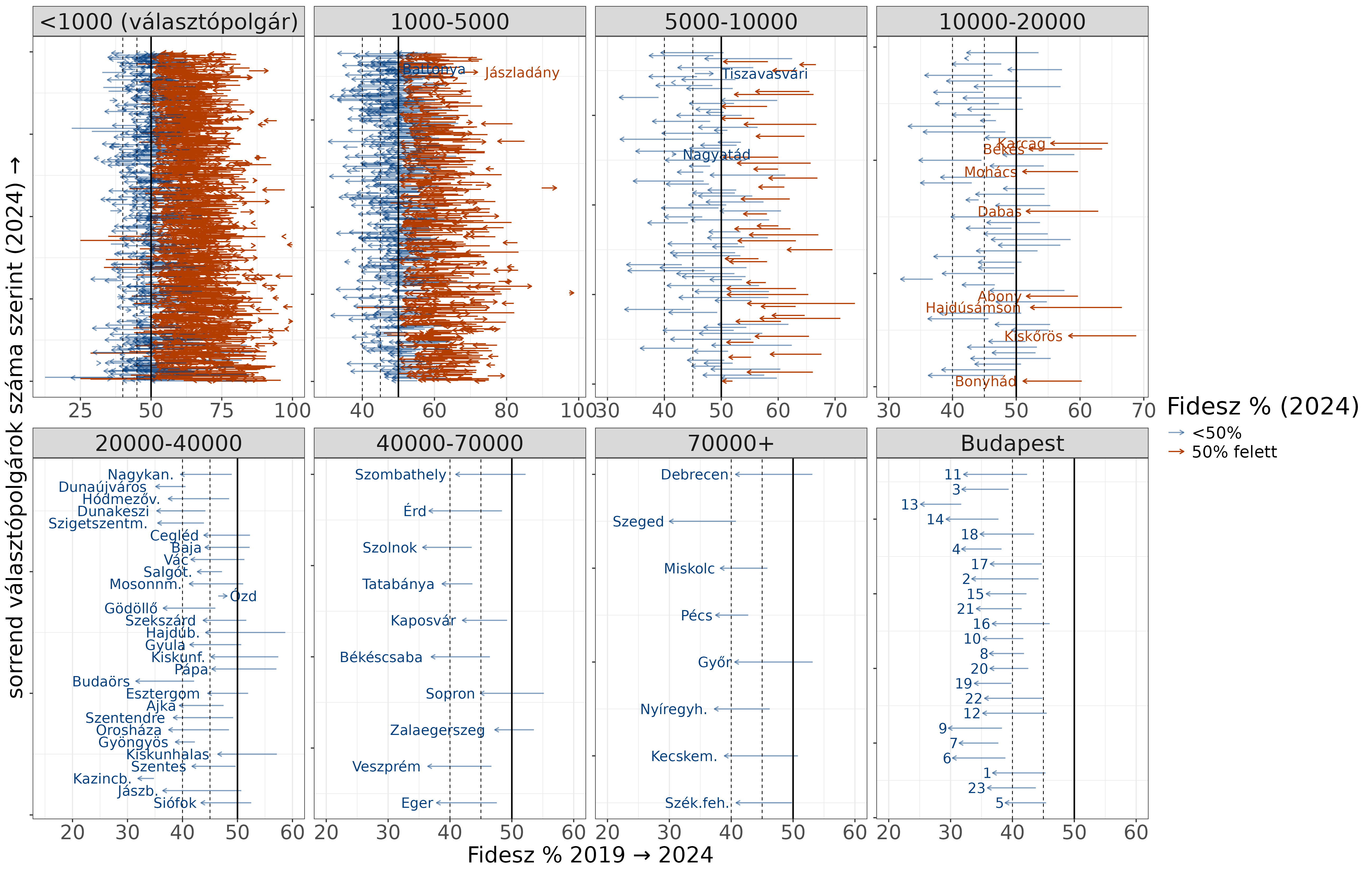
Figure 4: FIDESZ vote share in 2019 to 2024 (arrowhead=2024, base=2019) in all settlements of Hungary. Blue color shows vote share in 2024 under 50%, red above 50% [full resol.]
There were no towns/cities in EP2024 with more than 20 thousand voters where FIDESZ received more than 50% of the vote. The largest towns where they still have an absolute majority are ones with 10-20 thousand voters.
What will decide parliamentary constituencies is the difference between the government and the opposition voting blocs. Figure 5 shows how the FIDESZ vs. opposition vote share difference changed from 2019 to 2024 (positive values meaning a larger percentage of votes for FIDESZ). In red color are those settlements where FIDESZ still maintained an advantage over the opposition voting bloc. There were only three cities with 20+ thousand voters where this was the case (Ózd, Kiskunhalas, Zalagerszeg [with a tiny difference]). Major cities with previously large FIDESZ majorities such as Debrecen, Győr, Kecskemét, Szombathely, Sopron, Kaposvár had in 2024 more people voting for (non-far-right) opposition parties than for the government. In already opposition-majority areas like Budapest, Szeged, Pécs the opposition bloc’s edge over the government increased further.
On the other hand, in towns/villages with less than 5 thousand voters FIDESZ still mostly dominated, whereas in the medium range of towns with 5 to 20 thousand voters it is a mix.
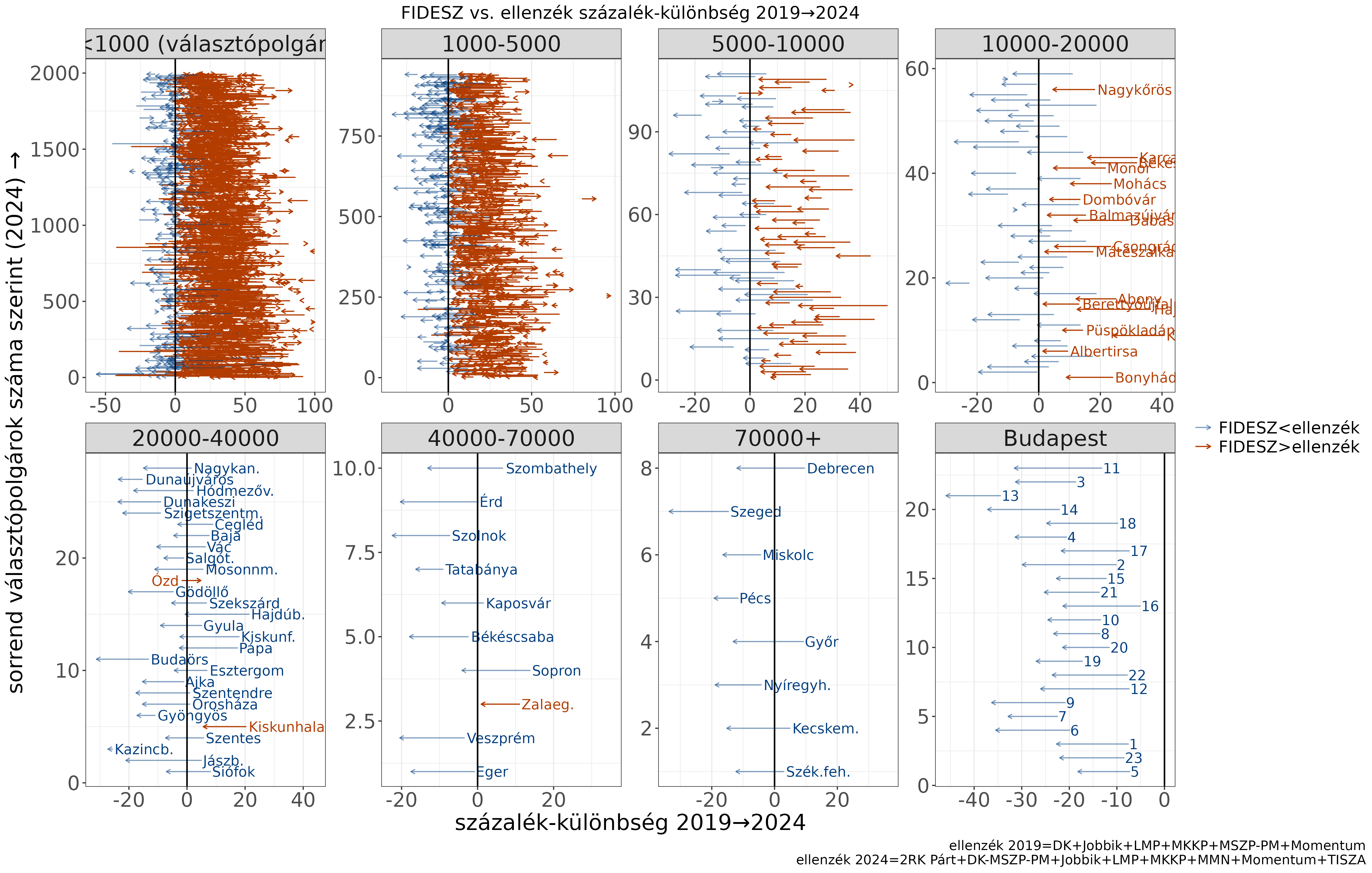
Figure 5: difference between the FIDESZ vote share and that of the opposition in 2019 and 2024 (arrowhead=2024, base=2019). Blue color shows the opposition getting more votes in 2024 than FIDESZ. Negative value means the opposition had a higher vote share than FIDESZ [full resol.]
Even in smaller towns of 1 to 10 thousand voters most of the arrows seem to point leftward, meaning a shrinking FIDESZ advantage (red arrows in Figure 5) or towns tipping over to the opposition (blue arrows in Figure 5).
Figure 6 shows the same results by colour coding the results by the direction of the change.
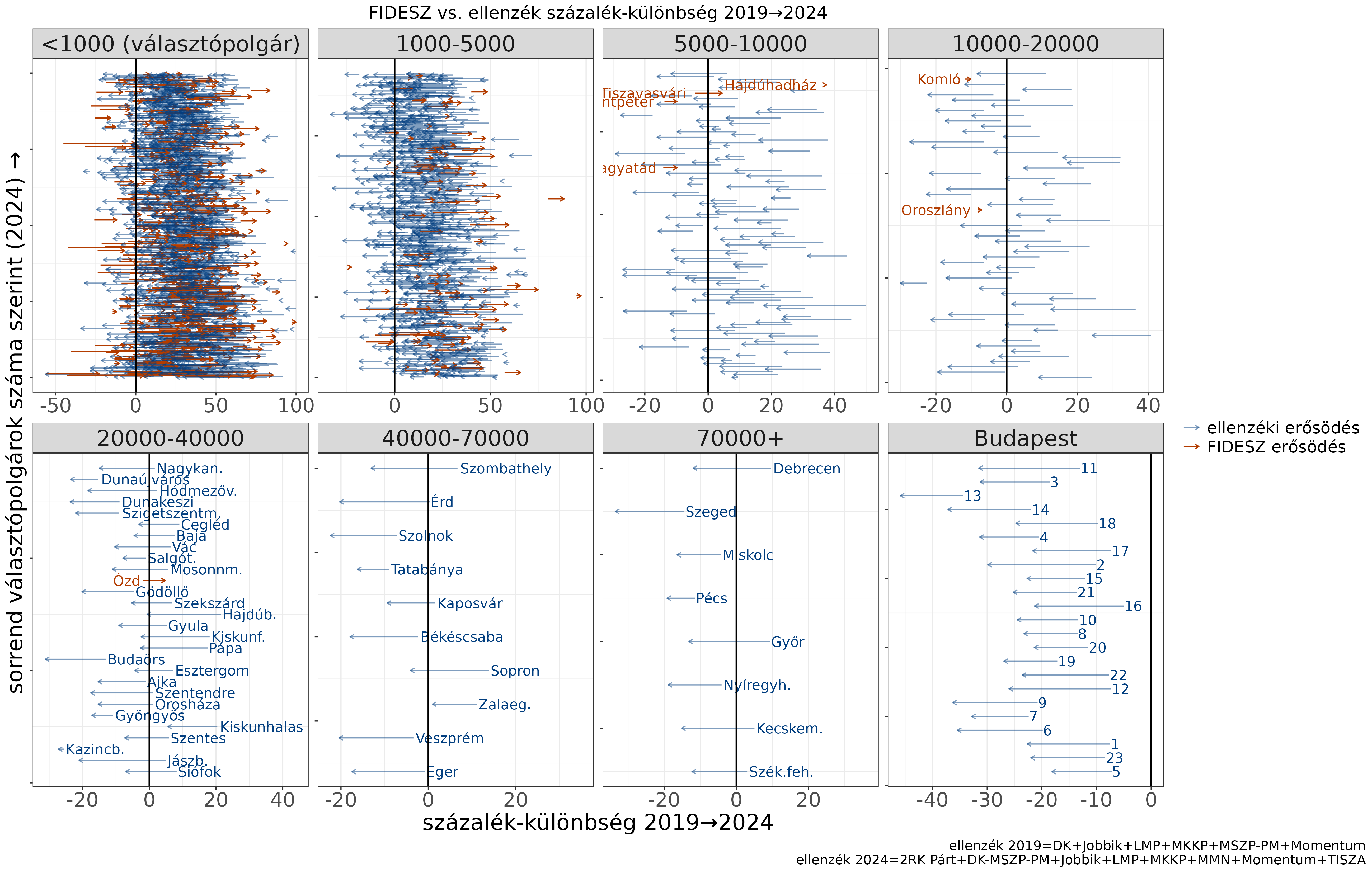
Figure 6: difference between the FIDESZ vote share and that of the opposition in 2019 and 2024 (arrowhead=2024, base=2019). Blue color shows the opposition improving its result since 2019 against FIDESZ. Negative value means the opposition had a higher vote share than FIDESZ [full resol.]
There are only three towns/cities over 10 thousand where FIDESZ improved its result compared to the opposition (Ózd, Komlo, Oroszlany), and even in 5-10 thousand towns only four. There were numerous villages on the other hand where FIDESZ managed to do this.
Next I summarise these shifts by aggregating results of individual towns by these categories.
Results aggregated by settlement types
Figure 7 shows results if we aggregate them from individual settlements, again grouping them by number of voters. The total number of votes increased from 2019 to 2024, on the national level going from 3.41 to 4.57 million. Of this 1.16 million increase approximately 680 thousand went to the non-far-right opposition, 220 thousand to FIDESZ and 190 thousand to Mi Hazánk.
However, these shifts looked very different at the level of different geographies. In absolute number of votes FIDESZ stood still (or marginally went down) in Budapest, and towns/cities with more than 5000 voters. As the opposition managed to increase its vote numbers this meant falling vote shares for FIDESZ, now going below 50% in all categories above the 5000 voter threshold, and falling below 40% in the category of 40+ thousand cities, where the opposition voting bloc went over 50%. In the category of towns with 5 to 10 thousand voters FIDESZ still maintained a thin relative majority, while it still maintains an absolute majority in the category of <5 thousand towns and villages. The FIDESZ mobilisation seemed to have worked only in this latter small town/village category, though interestingly it coincided with a comparable mobilisation of opposition voters as well.
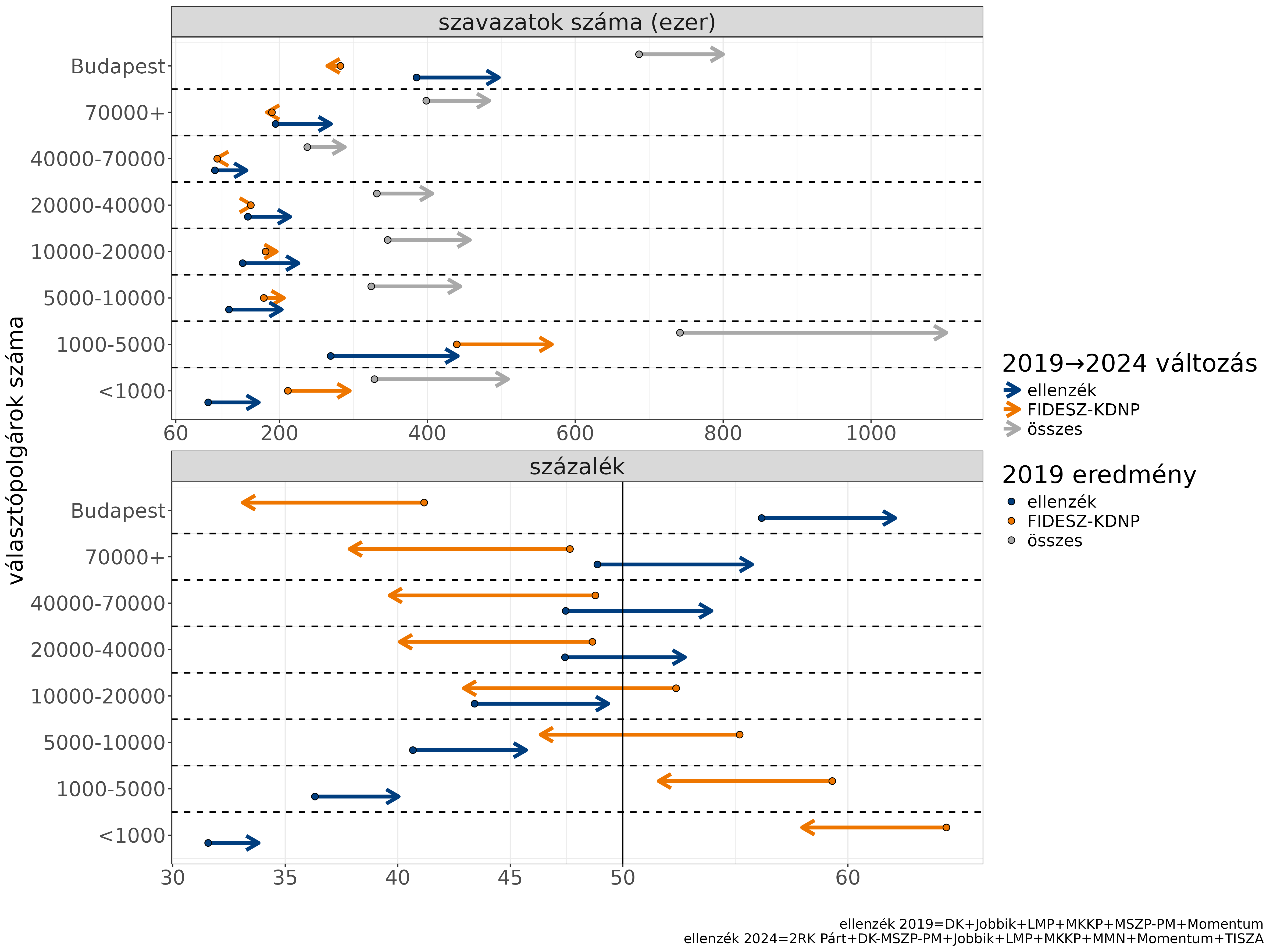
Figure 7: Vote share and number of votes for FIDESZ and the opposition in 2019 and 2024 (arrowhead=2024, base=2019), by settlement type. [full resol.]
Figure 8 shows only the changes in the absolute and relative size of voting blocs, also showing the far-right Mi Hazánk increasing both its vote tally and vote share (+3-4%) across all categories.
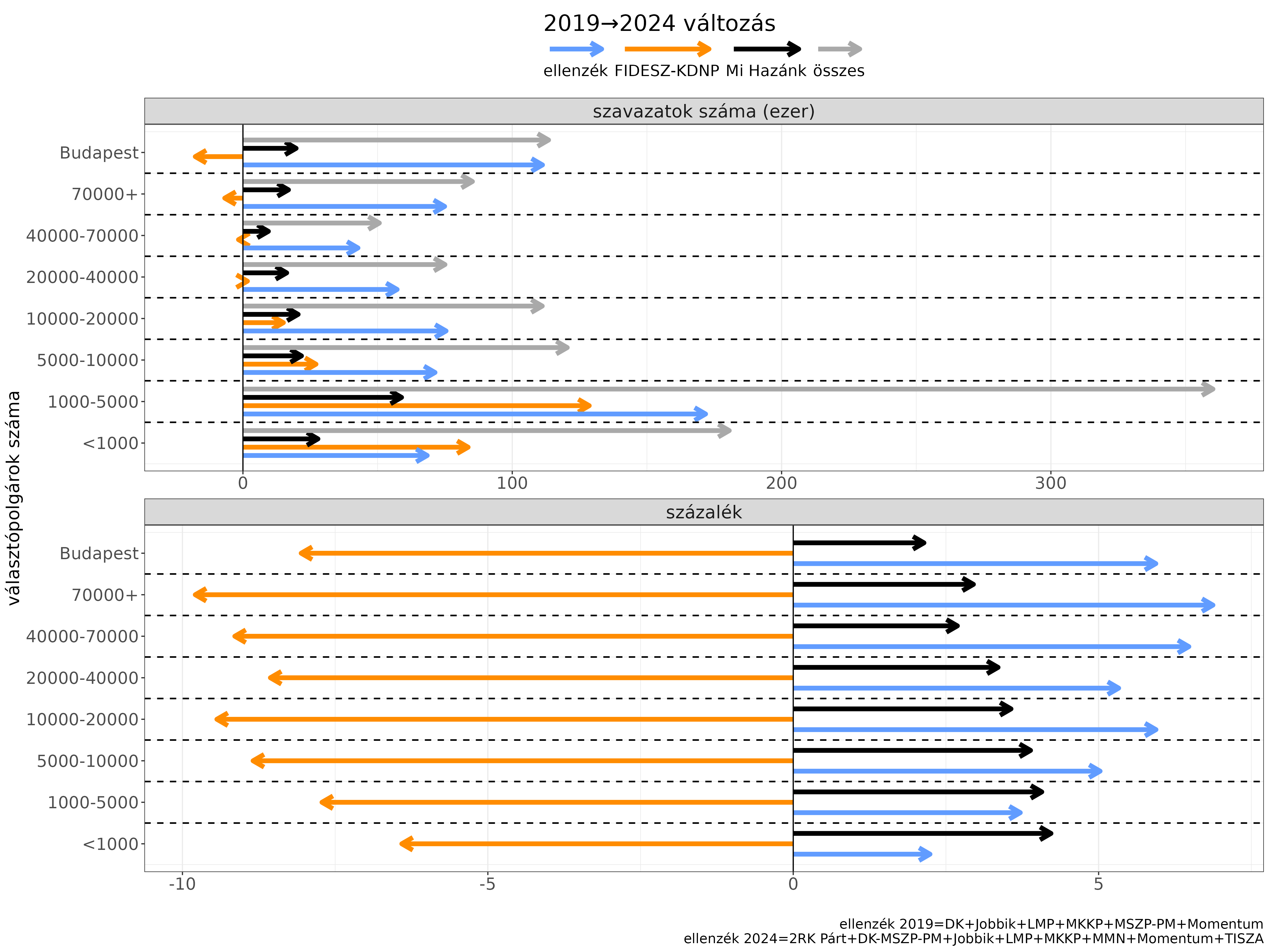
Figure 8: Change in the vote share and number of votes for FIDESZ and the opposition in 2019 and 2024 (0=2019 result), by settlement type. [full resol.]
We can also observe that the FIDESZ vote share fell by 6 to 10% across the board, while the non-far-right opposition’s went up by 2 to 5%.
It is also interesting to look at the number of settlements where there is a government or opposition majority, shown on Figure 9.
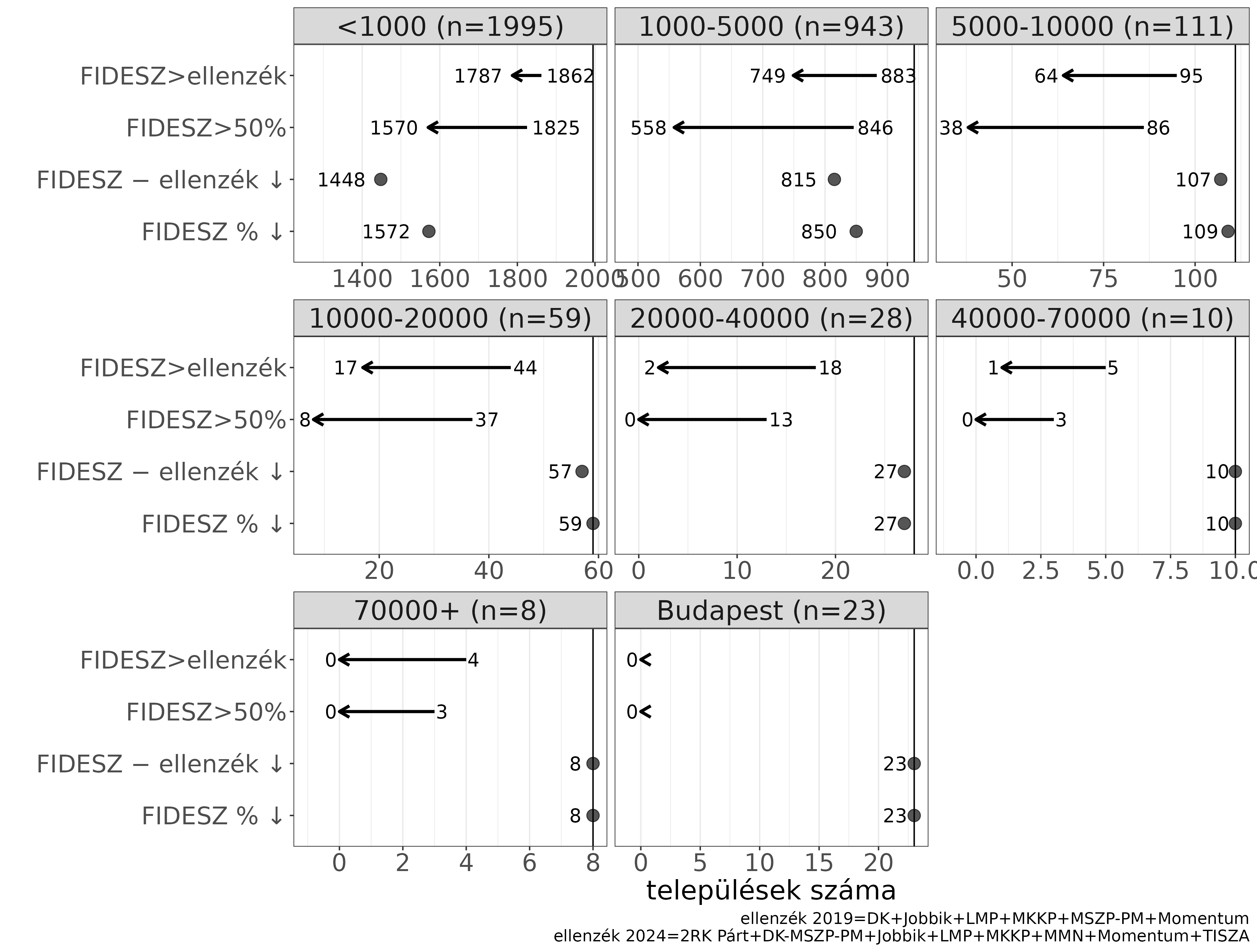
Figure 9: Number of settlements where 1) FIDESZ got more votes than the opposition in 2019 and 2024 (arrowhead) 2) FIDESZ received more than 50% of the vote in 2019 (arrow base) and 2024 (arrowhead) 3) the difference in vote share between FIDESZ and the opposition went down (opposition improved its result) from 2019 to 2024 4) FIDESZ vote share went down from 2019 to 2024. Panels correspond to settlements within a given settlement category (number of voters) [full resol.]
Among settlements with more than 20 thousand voters (including Budapest districts), there were none in 2024 with a FIDESZ absolute majority and only three with a relative FIDESZ majority. In 17/59 towns with 10 to 20 thousand voters, FIDESZ still maintained a relative majority (8/59 absolute). Going down by population size we have a growing proportion of towns with a relative (absolute) FIDESZ majority, becoming overwhelming in villages:
- 5 to 10 thousand voters: 64 out of 111 (38/111)
- 1 to 5 thousand voters: 749 out of 943 (558/943)
- less than 1 thousand voters: 1787 out of 1995 (1570/1995)
The number of settlements with either a relative or absolute government majority went down in every category.
The main question is: how would these results convert into parliamentary constituencies?
Results by parliamentary constituencies
There are 106 parliamentary constituencies (OEVK) in Hungary. I mapped the above results from individual settlements onto these 106 electoral districts, shown on Figure 10. I took the non-far-right opposition parties as one bloc and calculated the percentage difference between the FIDESZ and opposition voting blocs, with the colour coding showing districts going for FIDESZ (orange) or the opposition (blue).

Figure 10: EP2024 results mapped onto parliamentary constituencies (OEVK), showing the percentage difference (numbers in parenthesis, positive values are FIDESZ majorities) between FIDESZ and opposition votes. Orange circles show FIDESZ majorities, blue ones opposition. [full resol.]
With the proportions of the EP2024 all Budapest parliamentary districts had opposition majorities, along with most of Pest county. The picture varies in the other counties, with city-dominated districts having strong opposition majorities, and vice versa for village-dominated districts.
This is however assuming that the opposition bloc will indeed be one bloc, ie. it will field a single candidate in every parliamentary constituency. Even if the FIDESZ vs opposition proportions of EP2024 were to hold, this is a (very) optimistic assumption from the point of view of the opposition, that might well not be true in 2026. So what level of integration would the opposition need to get this result, and what number of constituencies would they get at different levels of integration/splintering? This is what is shown on Figure 11, with the x-axis showing the percentage of EP2024 votes for the opposition going for a single candidate and the y-axis the resulting number of constituencies for the two blocs.
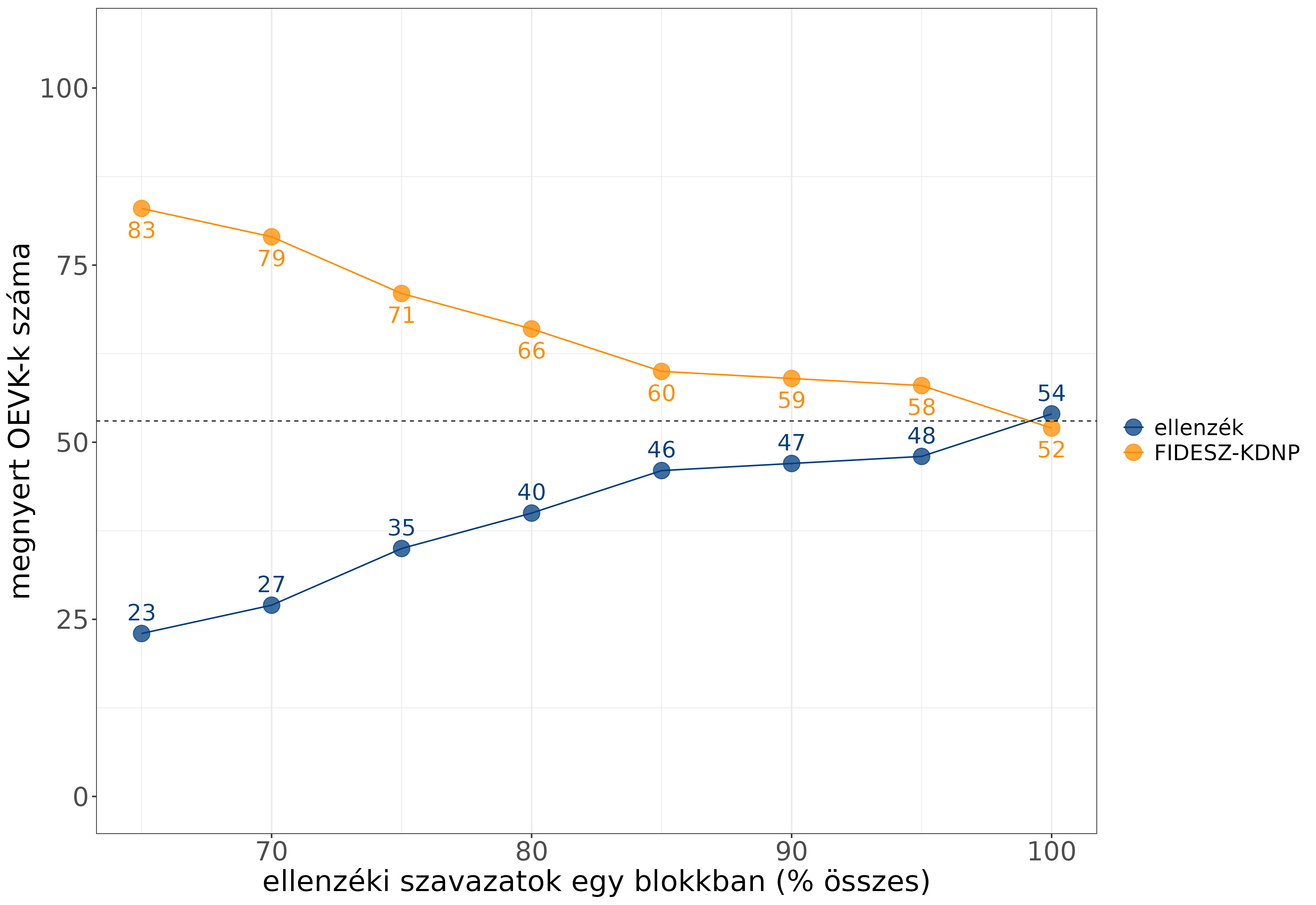
Figure 11: constituencies gained by FIDESZ vs the opposition as a function of the % of the opposition vote in EP2024 going for a single candidate [full resol.]
If the opposition were to field a single candidate everywhere and retain all its EP2024 votes, it could win a slim majority of constituencies, 54 vs 52. The largest opposition party in the 2024 elections, TISZA, received \(\approx\)65% of the opposition vote. With this level of integration FIDESZ could still win about 4/5th of constituencies, despite receiving 150 thousand (3.3% of the total) less votes than the non-far-right opposition.
Conclusion
The above is only a numerical and visual analysis, not a political one. It analyses the results in 2024 and when it maps them onto parliamentary constituencies to make a projection (not a prediction) it assumes that the proportions of the EP2024 would hold.
In reality, this latter assumption is unlikely be true, as the political situation in Hungary is very volatile and both the government and the main opposition party will try hard to shift the balance. Nevertheless, what the analysis shows is that while FIDESZ suffered a substantial erosion of its voting bloc, even with this result, it would easily win a parliamentary election if the opposition voting bloc is at all splintered. Even if the main opposition party managed to absorb the entire non-far-right voting bloc and the EP2024 proportions were to hold, it could get only a slim majority of parliamentary constituencies.
The Hungarian electoral system is two-tier, and another 93 seats will be allocated through the national list, where FIDESZ usually gets another 200-250 thousand votes from Hungarians living in neighbouring countries. This would effectively wipe out the 3% edge that the opposition had nationally at EP2024. This in turn would mean a roughly equal number of seats from the national list for the two blocs, but also 5-8 seats for the Mi Hazánk party if they clear the 5% threshold, as they did in 2024. So the EP2024 results, even assuming complete integration of the opposition voting bloc, could well end up in a hung parliament, with Mi Hazánk potentially in a kingmaker position.
Since the numbers will likely change, it makes no sense to dwell more on the numerical projections. The main unknown of the EP2024 election is where one million FIDESZ voters from the 2022 general election (GE2022) disappeared. Of course this was an EP rather than a general election, but the (pro)government media machinery switched to its highest gear with its ‘anti-war’ campaign to turn out the base. Despite this, while 3.06 million people voted for FIDESZ in the GE2022, this fell to 2.05 million in EP2024. Meanwhile, compared to the GE2022, the opposition managed to marginally increase its vote tally by 66 thousand.
The main question is if the one million ‘disappeared’ FIDESZ voters can be re-mobilised by the government for the GE2026. If to a large extent yes, then they would almost certainly win in 2026. If not, or only in small part, then the question in turn would be if the opposition reached its upper limit in EP2024 or there is a reservoir of voters who did not turn out in 2024 but could in 2026 or there are GE2022 FIDESZ voters that it could win over. The analysis above suggests that for the opposition to win, it would likely need more voters than the 2.2 million it had in EP2024, because even in the best case (zero loss of opposition votes due to competing candidates), the EP2024 result would only be enough for a hung parliament or a razor thin majority.
The town- and constituency-level analysis above suggests what could be districts where FIDESZ is particularly vulnerable, having thin majorities and suffered major losses compared to its previous results. Whether the opposition will be able to exploit that remains to be seen.
Source code
Source code and data files for plots at Github repo.
politics hungary elections data-visualisation